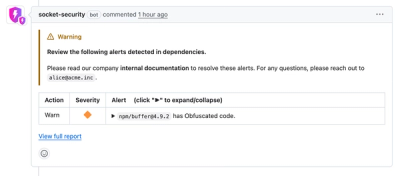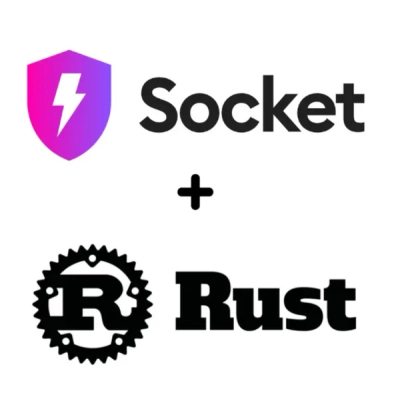
Security News
Crates.io Users Targeted by Phishing Emails
The Rust Security Response WG is warning of phishing emails from rustfoundation.dev targeting crates.io users.
influxdb-light
Advanced tools
A light-weight client to read & write data to InfluxDb v1 and v2. This client supports both InfluxQL(SQL) and Flux queries
A light-weight client to read and write data to InfluxDb V1 and V2.
It supports both InfluxQL(SQL) and Flux queries.
This light-weight client is incredibly easy to use.
Handling of tags and fields is straightforward with no additional complexity.
You have to create a DBRP mapping if you want to use InfluxQL(SQL) on your V2 buckets.
For more details on DBRP mapping please read this guide.
npm i influxdb-light
import { InfluxDB } from "influxdb-light";
const request = {
host: "localhost",
port: "8086",
protocol: "http",
username: "<username>",
password: "<password>"
};
const influxDb = new InfluxDB(request);
const dbName = "demo1";
const measurement = "energy";
//Write to InfluxDb
influxDb.writeV1({
measurement: measurement,
payload: [{ //You can store multiple data point at once.
deviceId: "d007",
location: "L007",
type: 7,
enabled: true,
valueX: 100,
valueY: 120,
ip: "192.168.0.2"
}, {
deviceId: "d009",
location: "L009",
type: 9,
enabled: false,
valueX: 110,
valueY: 130,
ip: "192.168.0.3"
}],
tags: ["deviceId", "location", "type", "enabled"],
timestamp: 1664821800000000000 //timestamp is optional. Use this if you want to explicitly set different time.
},
dbName,
// queryParams is optional. see WriteV1QueryParams
{
rp: 'autogen', // retention policy
consistency: 'all'
})
.then(res => {
console.log(res);
//Output: [] //Empty array indicates data added
}).catch(err => {
console.error(err);
});
//Read from InfluxDb
influxDb.queryV1(dbName, `SELECT * FROM ${measurement} WHERE "deviceId"='d007'`)
.then(res => {
console.log(res);
//Output:
// [
// {
// "statement_id": <number>,
// "series": [
// {
// "name": <string>,
// "columns": Array<string>,
// "values": Array<Array<string | number | boolean | null>>
// }
// ]
// }
// ]
}).catch(err => {
console.error(err);
});
import { InfluxDB } from "influxdb-light";
const request = {
host: "localhost",
port: "8086",
protocol: "http",
token: "<token_value>"
};
const influxDb = new InfluxDB(request);
const org = "demo_org";
const dbName = "demo1";
const measurement = "energy";
const precision = "ns"; // precision is unit about timestamp of payload. and it's optional parameter.
//Write to InfluxDb
influxDb.writeV2({
measurement: measurement,
payload: [{ //You can store multiple data point at once.
deviceId: "d007",
location: "L007",
type: 7,
enabled: true,
valueX: 100,
valueY: 120,
ip: "192.168.0.2"
}, {
deviceId: "d009",
location: "L009",
type: 9,
enabled: false,
valueX: 110,
valueY: 130,
ip: "192.168.0.3"
}],
tags: ["deviceId", "location", "type", "enabled"],
timestamp: 1664821800000000000 //timestamp is optional. Use this if you want to explicitly set different time.
}, org, dbName, precision)
.then(res => {
console.log(res);
//Output: [] //Empty array indicates data added
}).catch(err => {
console.error(err);
});
//Read from InfluxDb
influxDb.queryV2("orgtest", `from(bucket:"demo1") |>
range(start: -60d) |>
filter(fn: (r) => r._measurement == "energy") |>
filter(fn: (r) => r.deviceId == "d007") |>
pivot(rowKey: ["_time"], columnKey: ["_field"], valueColumn: "_value")`))
.then(res => {
console.log(res);
//Output: /*Returns string with comma separation. To be parsed as csv*/
//,result,table,_start,_stop,_time,_measurement,deviceId,enabled,location,type,ip,valueX,valueY
//,_result,0,2022-07-11T10:50:17.6390562Z,2022-09-09T10:50:17.6390562Z,
//2022-09-09T10:46:09.3298829Z,energy,d007,false,L007,7,192.168.0.2,100,120
}).catch(err => {
console.error(err);
});
import { InfluxDB } from "influxdb-light";
const influxDb = new InfluxDB({ host: "localhost", port: "8086", protocol: "http", token: "<token_value>" });
//Create a Bucket
influxDb.createBucket(<org_ID>, <bucket_name>, <retention_in_seconds>)
//output: { bucketId: <string>, name: <string>, createdAt: <string>, retentionTime: <number> }
//Get specific bucket
//i). By Bucket ID
influxDb.getBucket("640bee9277f75f2d", { id: "10592e2bff3d1789" }).then(result => console.log(result));
//ii). By Bucket Name
influxDb.getBucket("640bee9277f75f2d", { name: "testBucket007" }).then(result => console.log(result));
//output: { bucketId: <string>, name: <string>, createdAt: <string>, retentionTime: <number> }
//List All Buckets
influxDb.listBuckets("640bee9277f75f2d").then(result => console.log(result));
//output: Array<{ bucketId: <string>, name: <string>, createdAt: <string>, retentionTime: <number> }>
FAQs
A light-weight client to read & write data to InfluxDb v1 and v2. This client supports both InfluxQL(SQL) and Flux queries
The npm package influxdb-light receives a total of 5 weekly downloads. As such, influxdb-light popularity was classified as not popular.
We found that influxdb-light demonstrated a not healthy version release cadence and project activity because the last version was released a year ago. It has 1 open source maintainer collaborating on the project.
Did you know?

Socket for GitHub automatically highlights issues in each pull request and monitors the health of all your open source dependencies. Discover the contents of your packages and block harmful activity before you install or update your dependencies.

Security News
The Rust Security Response WG is warning of phishing emails from rustfoundation.dev targeting crates.io users.

Product
Socket now lets you customize pull request alert headers, helping security teams share clear guidance right in PRs to speed reviews and reduce back-and-forth.

Product
Socket's Rust support is moving to Beta: all users can scan Cargo projects and generate SBOMs, including Cargo.toml-only crates, with Rust-aware supply chain checks.